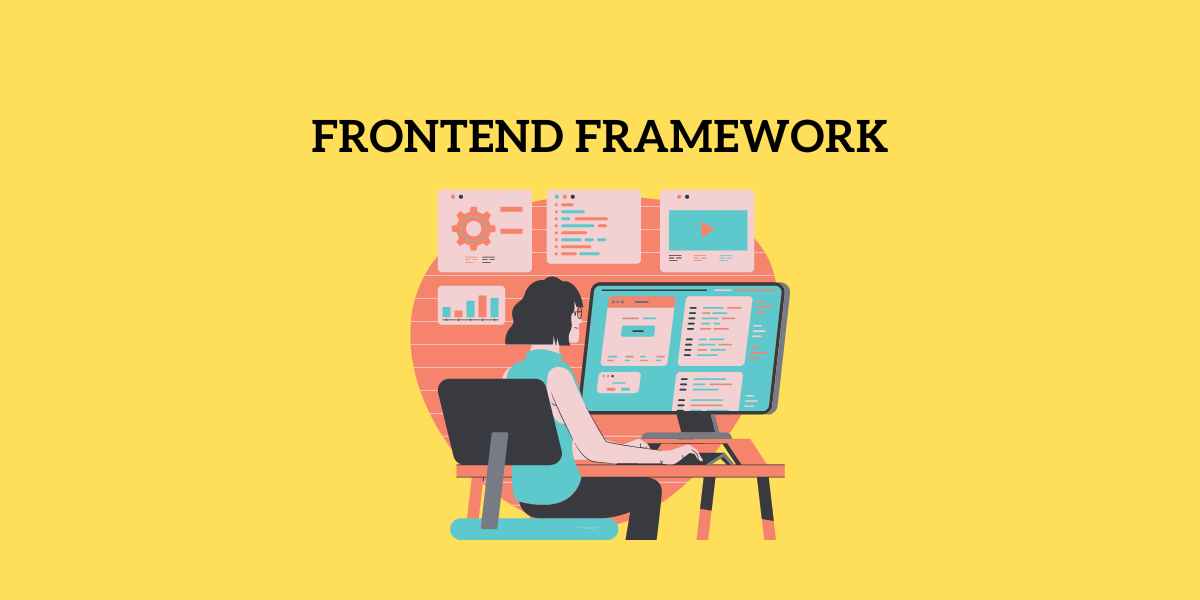- Tech
- No Comment
Choose the Right Frontend Framework for Your Project

Choosing the proper frontend framework in web development can be a make-or-break decision for your project. The options are vast, each with strengths and nuances, making it essential to navigate this landscape wisely. This blog will serve as your compass, guiding you through selecting the ideal frontend framework for your project. We’ll explore various frameworks, delve into critical factors to consider, and offer insights into making a well-informed decision.
The Role of Front-end Frameworks
Front-end frameworks are the backbone of modern web development, providing developers with essential tools and libraries to build robust and responsive user interfaces. These frameworks streamline the development process, promote code reusability, and enhance collaboration within development teams. They empower developers to create feature-rich and interactive web applications efficiently.
When you choose a front-end framework, you’re not merely selecting a tool but adopting a development philosophy. React, for example, is known for its component-based architecture, while Angular offers a comprehensive ecosystem for building dynamic applications. Vue.js, on the other hand, Vue.js is praised for its simplicity and ease of integration into existing projects. Understanding the role of these frameworks is the first step toward making an informed choice.
Types of Front-end Frameworks
Front-end frameworks come in various flavors, catering to project requirements and development preferences. JavaScript frameworks like React, Angular, and Vue.js are well-known for their capabilities in building single-page applications (SPAs). These frameworks deliver seamless user experiences by dynamically updating content without requiring full-page reloads.
Alternatively, multi-page application (MPA) frameworks like Ember.js and Backbone.js are designed for projects that involve multiple interconnected pages. They provide structure and organization, making managing complex projects with diverse content and user flows easier. The choice between SPAs and MPAs depends on your project’s specific needs, making it crucial to understand the distinctions between them.
Factors to Consider
Selecting the proper front-end framework involves carefully evaluating several critical factors. One of the foremost considerations is your project’s requirements. Is it a content-heavy website, a dynamic web application, or an e-commerce platform? Understanding your project’s objectives and features is essential in determining which framework aligns best with your goals.
Community support and documentation are equally vital aspects. A thriving community can provide valuable resources, plugins, and solutions to common challenges. Additionally, well-documented frameworks simplify the learning process and troubleshooting. A framework with extensive community support and thorough documentation can expedite your development journey.
The framework’s ecosystem is another aspect to scrutinize. Consider the availability of third-party libraries, plugins, and tools that complement the framework. These resources can enhance development capabilities and save time by providing pre-built solutions for everyday tasks. Evaluating the strength and vibrancy of the framework’s ecosystem is crucial for long-term project success.
Framework Comparison
A comprehensive comparison of the available options is essential in choosing the proper front-end framework. Let’s take a closer look at some popular frameworks:

React:
Known for its flexibility and performance, React is an ideal choice for building SPAs. Its component-based architecture encourages code reusability and boasts a vast community and a rich ecosystem of libraries and tools.
Angular:
Angular offers a comprehensive solution for developing dynamic web applications. It provides powerful features like two-way data binding and dependency injection. However, it has a steeper learning curve compared to some other frameworks.
Vue.js:
Vue.js strikes a balance between simplicity and versatility. Its gentle learning curve makes it an excellent choice for beginners and experienced developers. Vue’s reactive data-binding and component system facilitates efficient development.
Each of these frameworks has its strengths and is suited to specific types of projects. React excels in building user interfaces with high interactivity, Angular shines in complex applications with a lot of data manipulation, and Vue.js offers an easy learning curve and adaptability for various project sizes.
Project-specific Considerations
To make an informed decision, aligning the front-end framework with your project’s specific considerations is crucial. For example, if you’re building a real-time chat application, a framework with solid support for data synchronization and updates, like React with Firebase, might be an excellent fit. On the other hand, if you’re working on a content-focused blog, a lightweight framework like Vue.js can streamline development without unnecessary complexity.
Scalability is another factor to bear in mind. As your project grows, your front-end framework should be capable of accommodating increased complexity and traffic. Consider how well the framework scales and whether it can handle future expansion.
The mobile responsiveness of your project is a critical consideration, especially in the mobile-first digital landscape. Ensure your chosen framework supports responsive design and delivers a consistent user experience across various devices and screen sizes.
Development Team Skillset
The skill set of your development team plays a pivotal role in choosing the proper front-end framework. If your team has prior experience with a particular framework, leveraging their expertise can streamline development and reduce the learning curve. However, assessing their adaptability and readiness for the required training is essential if your team is open to learning a new framework.
Consider the availability of resources and support for your chosen framework. Can ample tutorials, courses, and documentation help your team become proficient? Additionally, evaluate the framework’s community and whether it offers active forums and user groups for troubleshooting and knowledge sharing.
Case Studies and Examples
Real-world case studies and examples can provide valuable insights into the practical application of front-end frameworks. Let’s explore a couple of scenarios:

Case Study 1:
E-commerce Website Imagine you’re tasked with developing a feature-rich e-commerce website. In this case, a framework like React or Angular might be suitable. Their robust capabilities for managing complex user interfaces, dynamic product catalogs, and real-time inventory updates align well with the project’s requirements. With a vast community and abundant e-commerce-specific libraries and plugins, these frameworks offer the necessary resources to expedite development.
Case Study 2:
Blogging Platform: Suppose you’re building a content-focused blogging platform. Here, Vue.js could be a pragmatic choice. Its simplicity and gentle learning curve make it an excellent option for smaller teams or projects with tight timelines. Vue’s reactive data-binding simplifies content updates and user interactions, creating a seamless reading experience for blog visitors.
These case studies illustrate how the choice of front-end framework can directly impact the development process and the user experience. You can enhance efficiency and deliver outstanding results by carefully aligning the framework with project requirements.
Future-Proofing Your Decision
Selecting the proper front-end framework isn’t just about the present; it’s about future-proofing your project. As technology evolves and user expectations change, your chosen framework should be adaptable and capable of accommodating new features and enhancements.
Stay informed about updates and advancements within your chosen framework. Many frameworks release new versions with improved performance, security, and features. Keeping your project up-to-date with the latest framework releases is essential for maintaining long-term stability and security.
Additionally, consider the scalability of your chosen framework. As your project gains traction and user traffic increases, your framework should be capable of handling the growing demand. Scalability ensures that your website or application can continue to perform optimally as it expands.
Finally, evaluate the long-term support and maintenance of the framework. Some frameworks have dedicated teams and communities that provide ongoing support and updates. Ensure that your chosen framework has a stable and active support ecosystem to address potential issues and security concerns in the future.
Making Your Decision
The decision-making process for selecting the proper front-end framework involves several steps:
- Define Your Project Requirements: Clearly define your project’s objectives, features, and user expectations. Understanding your project’s unique needs is the foundation for selecting the proper framework.
- Evaluate Framework Types: Consider whether a single-page application (SPA) or a multi-page application (MPA) framework suits your project. Each type has its strengths and use cases.
- Examine Critical Factors: Assess factors like community support, documentation, and the framework’s ecosystem. A thriving community and extensive documentation are indicators of a framework’s maturity and reliability.
- Compare Frameworks: Conduct a thorough comparison of popular front-end frameworks. Explore their features, strengths, and weaknesses to determine which aligns best with your project.
- Project-specific Considerations: Consider project-specific considerations, such as real-time updates, mobile responsiveness, and scalability. Ensure that your chosen framework can address these requirements effectively.
- Team Skillset: Consider your development team’s expertise and readiness to learn a new framework. Leverage existing skills when possible and evaluate the availability of training and resources for the chosen framework.
- Case Studies and Examples: Review real-world case studies and examples that showcase how different frameworks have successfully applied in similar projects. Draw insights from these scenarios to inform your decision.
- Future-Proofing: Think long-term and assess how well your chosen framework can adapt to future technological advancements and project growth.
- Development and Feedback: Start the development process and gather feedback from your team and stakeholders as you progress. Continuously evaluate whether the chosen framework aligns with your project’s goals and requirements.
Conclusion
Choosing the proper front-end framework for your project is a pivotal decision that can impact its success and efficiency. You can make an informed choice by considering project requirements, evaluating framework types, examining critical factors, comparing options, and factoring in project-specific considerations. Leverage your team’s skillset, review case studies, and plan for future-proofing to ensure your chosen framework aligns with your long-term goals.
Remember that the decision-making process is not set in stone; it’s an iterative journey. As your project evolves and user needs change, be prepared to adapt and refine your framework selection to ensure it continues serving your project’s objectives effectively. With the proper front-end framework, you can confidently embark on your web development journey, knowing you’ve equipped your project with the tools needed for success.